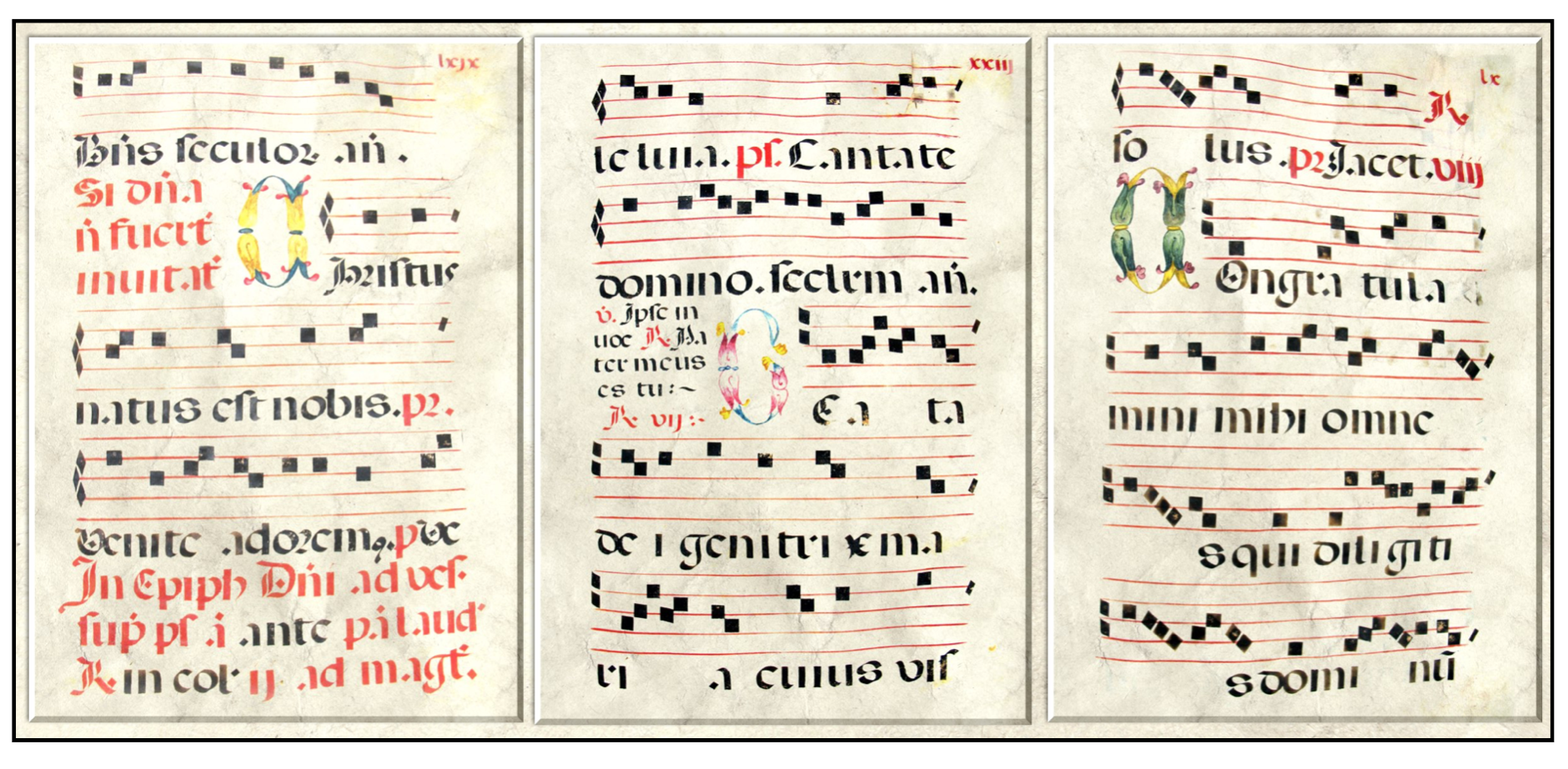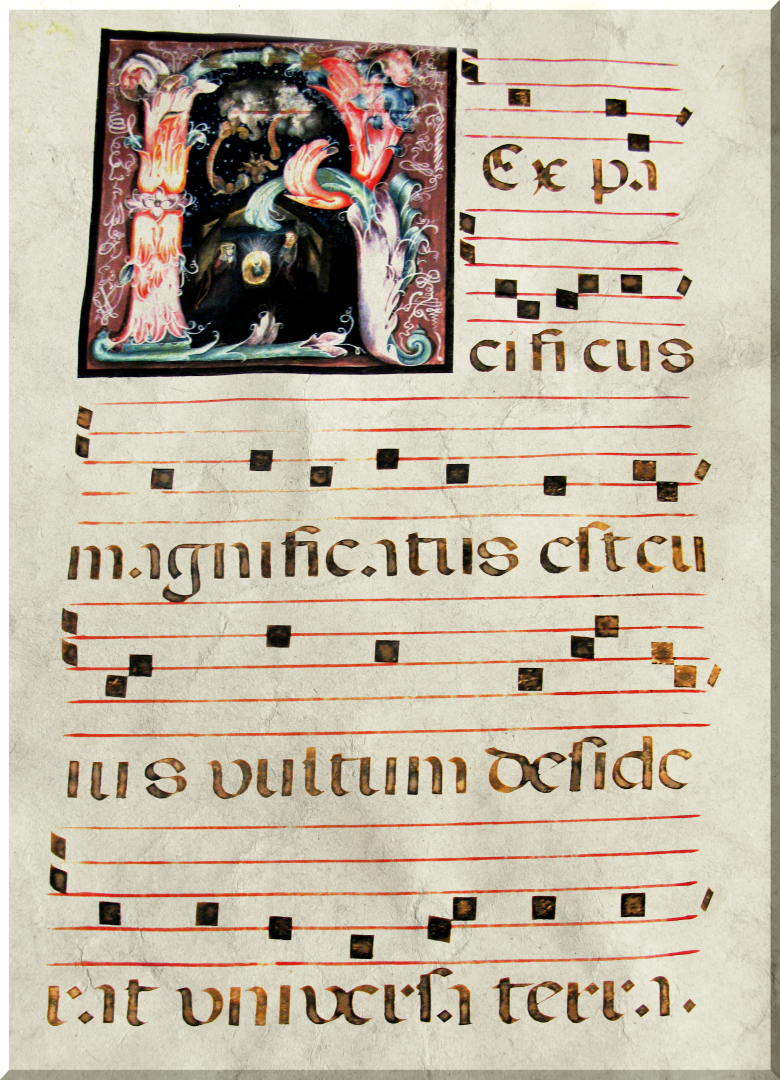Antiphonary
Italian, 16th century
Below the image, click play to listen.
This object is currently on display in Mack Library.
Italian, 16th century
Below the image, click play to listen.
Walnut and pine
German, 17th century
Storage has been one of humanity’s challenges through the ages. “Where do I put this?” is a question many of us may ask numerous times a day. In the digital world it can be more challenging: “Which folder do I store this in?”
The schrank is an evolution of the storage chests from the Middle Ages. When it was discovered that chests placed on top of each other with front-opening doors were more useful, the schrank in miniature was introduced. At that time, it was called a cupboard. Later modifications of enlarging them gave us what is commonly called an armoire, which normally contained more compartments in the top section than a schrank.
For practical purposes, both the schrank and armoire are used for storage, and the word is used interchangeably by many people. However, the difference between the two is more technical and geographical. Initially used to store armor, the French named the cabinet an armoire. The schrank was so named by the Germans. The term is still part of several words used to describe a storage item, most notably a kuhlschrank or what is known to us Americans as a refrigerator.
M&G’s Schrank joined the collection in 1964. It may have originated in southern Germany and was constructed in the 17th century or later. The last owner prior to M&G was A. S. W. Rosenbach, an antique book collector and dealer living in Philadelphia during the last half of the 19th century into the mid-20th century. His aggressive skill and vast knowledge of books made him “The Terror of the Auction Room.”
The Schrank’s upper carcass is constructed with a single pine board for each side, top, and bottom. The lower carcass uses a single pine board for each side as well as the back and bottom—the lower portion doesn’t need a top since the upper section rests on it. Finely detailed, hand-sawn dovetail joints can be seen on the top of the upper carcass. Carved walnut is used for the decorative ornamentation for the front.
 The left door panel displays a common 17th-century scene of Michael the Archangel overcoming Satan, in the form of a dragon. The other door depicts the apocryphal characters of the archangel Raphael with Tobias. The Book of Tobit from the Apocrypha gives detail to the legend presented. Other aspects of the ornamentation have been described in technical terms by Joseph Aronson in his catalog Furniture in the Bob Jones Collection. “The base cupboard features low doors paneled with wave-mouldings framing lion-heads, and its corners are embellished with panels framing scrolls. The astragal is a caryatid figure like the upper. The base mold, like the other horizontals, is quiet and rests on bun feet.”
The left door panel displays a common 17th-century scene of Michael the Archangel overcoming Satan, in the form of a dragon. The other door depicts the apocryphal characters of the archangel Raphael with Tobias. The Book of Tobit from the Apocrypha gives detail to the legend presented. Other aspects of the ornamentation have been described in technical terms by Joseph Aronson in his catalog Furniture in the Bob Jones Collection. “The base cupboard features low doors paneled with wave-mouldings framing lion-heads, and its corners are embellished with panels framing scrolls. The astragal is a caryatid figure like the upper. The base mold, like the other horizontals, is quiet and rests on bun feet.”
Though the original craftsman is unknown, this piece of furniture represents well the skilled carving and furniture making from an era that no longer exists. Considering this Schrank was also part of a well-known bibliophile’s furnishings adds intrigue as to what treasures it may have stored more than a century ago.
John Good, Security Manager
Published in 2019
Vellum
Italian, 16th century
 Antiphonary pages from the Museum & Gallery at Bob Jones University
Antiphonary pages from the Museum & Gallery at Bob Jones University
Antiphonaries are collections of various chants sung for the prayer hours, the Divine Office, of the Western church. Such collections date as far back as the eighth century. The chants consist primarily of antiphons and psalms. In the Middle Ages all 150 psalms were sung each week during the Divine Office.
Antiphons were musical and textual additions which anonymous medieval composers added to the chanting of the psalm. Most often the antiphon texts were carefully selected to match the content of the psalm at hand. They could be drawn from other biblical passages, including the New Testament, from older hymns, or from new, original texts. For example, for the chanting of Psalm 23, the antiphon text might have been from John 10:11, “I am the good shepherd.” This antiphon text would be sung before and after the chanting of the psalm, forming a musical frame.
The collections would be organized according to the church calendar and within that according to the order of the prayer hours beginning with Matins. Antiphonaries are generally quite large because the choir would stand around it in a group in order to sing from it, similar to the picture below. A large music stand held it at the proper level.
The Antiphonary in M&G’s collection dates to the beginning of the 16th century. It came to M&G in 1960 acquired at an auction on November 11 and 12 at the Parke-Bernet Galleries from the Myron C. Taylor Collection, NY.
M&G’s Antiphonary is incomplete, consisting of 154 leaves (pages). The parts of the church calendar within it include the Offices for the Christmas feasts, the Circumcision, the Epiphany, the Ascension, and Pentecost. Notably absent are the services for Easter.
 Similar to many other antiphonaries, this one also illuminates and decorates many capital letters. The first line of this page reads Rex pacificus magnificatus translated as “The King of Peace is magnified.” The first letter, the R, contains a nativity scene, colored in pastels, appropriate to its position for Vespers on Christmas Day. M&G is beginning to translate the leaves in the antiphonary and orient them to their position in the church calendar and order of service.
Similar to many other antiphonaries, this one also illuminates and decorates many capital letters. The first line of this page reads Rex pacificus magnificatus translated as “The King of Peace is magnified.” The first letter, the R, contains a nativity scene, colored in pastels, appropriate to its position for Vespers on Christmas Day. M&G is beginning to translate the leaves in the antiphonary and orient them to their position in the church calendar and order of service.
Dr. Karen Wilson, M&G volunteer and retired music professor from Bob Jones University
Published in 2018